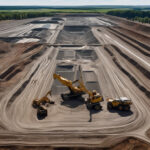In an impressive advancement within European telecommunications, A1 Austria, Eurofiber, and Quantcom have united to develop a high-speed dark-fibre network connecting Frankfurt and Vienna. This ambitious project, which is expected to be operational by December 2025, aims to provide an ultra-low-latency infrastructure, vital for modern telecommunications demands.
The collaboration between these three firms signifies more than just an increase in network capacity; it represents a fundamental improvement in connectivity that could transform various sectors. By enhancing the technical capabilities of the network, the partners aim to bolster services such as cloud computing, media broadcasting, artificial intelligence (AI), and machine learning (ML). Current estimates indicate that as businesses increasingly rely on digital solutions, the demand for swift and reliable data transfer is more critical than ever.
Latency is a significant factor in network performance, particularly in sectors where every millisecond counts. For instance, financial trading firms depend on low latency to execute trades quickly, while streaming services require stable connections to provide uninterrupted content. The new dark-fibre network is designed to alleviate these issues, making it an essential asset for telecommunications companies, fixed network operators, and various industries throughout the region.
The construction of this network is not without economic implications. By providing improved connectivity, this infrastructure is poised to act as a backbone for the digital ecosystem in Europe. Enhanced data exchange capabilities will allow businesses to streamline operations and innovate in ways that were previously unattainable. Economies stand to benefit from an expanded digital framework that can facilitate growth across many sectors, from finance to entertainment.
In tandem with increasing network capacity, the project addresses the pressing demand for improved digital infrastructure. Modern users expect reliable and fast connectivity, which is often not met with existing systems. By laying the groundwork for a more sophisticated network, this collaboration ensures that European industries can thrive in a competitive global market.
Beyond sheer bandwidth, investing in dark-fibre networks is also strategic for future developments. This initiative opens avenues for the deployment of advanced technologies like AI and IoT (Internet of Things), which depend heavily on reliable connectivity. For example, smart cities in Europe that leverage IoT technologies for traffic management and energy efficiency will find this network integral to their operational success.
Moreover, this partnership reinforces a trend in the telecommunications sector where collaborations are becoming essential to cope with the complexity and expense of infrastructure deployment. The cost-sharing and resource pooling between these companies offer a practical framework for tackling the challenges of modern telecommunications.
To navigate the complexities of digital infrastructure and ensure they yield positive outcomes, stakeholders must understand the multifaceted benefits that such initiatives bring. Improved connectivity leads to better business performance, which in turn stimulates economic growth and innovation. As this dark-fibre network takes shape, it will not only enhance geographical connectivity but will also create new opportunities for various industries.
In summary, the effort to establish a high-speed dark-fibre network between Frankfurt and Vienna signifies a strategic move to bolster European telecommunications. Set for completion by 2025, this collaboration reflects the industry’s recognition of connectivity as a vital driver of economic prosperity and technological advancement. By fostering collaboration and investing in infrastructure, stakeholders are paving the way for a more interconnected and efficient future throughout the region.












